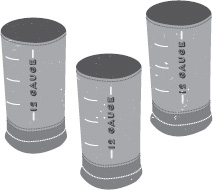Uncle John’s Bathroom Reader Weird Inventions (23 page)
Read Uncle John’s Bathroom Reader Weird Inventions Online
Authors: Bathroom Readers’ Institute

T
attoos and piercings are so yesterday. This strange form of body modification is known in Japan, where it’s been popular for nearly a decade, as
seerin durippu
, or “saline drip.” Technicians insert a needle in the client’s forehead and inject about 400 cc of a harmless saline solution, which creates a large bulge just under the skin. The technician then uses their thumb to create an indentation in the middle of the bump. The whole procedure takes around two hours, and the end result looks like a subcutaneous bagel.
“Bagel bumps” are temporary. It typically takes between 16 and 24 hours for the body to absorb all the saline and the forehead to return to its normal shape. Unlike a tattoo or a facial piercing, a bagelhead will turn heads on Saturday night, but fade away by Monday morning.
Japanese journalist Ryoichi “Keroppy” Maeda popularized bagelheads. He’s been covering Japanese body modification fads since the early 1990s. At a body mod convention in 1999, Maeda ran into an artist named Jerome Abramovitch, who was experimenting with saline infusions. With Abramovich’s permission, Maeda began organizing bagelhead booths for parties and events around Tokyo. The fad took off from there, and more daring fans of the procedure have begun injecting saline into
other
body parts.
G
oogle is probably the world’s leading research-and-development company, particularly with its well-funded (but highly secretive) Google X division trying to make sci-fi a reality. Founded by CEO Larry Page in 2005, one of the division’s primary directives is to eventually create a direct line between the human brain and consumer technology powered by Google’s many online services.
Google envisions a future in which you don’t have to type or even look anything up on a computer—just think of what you need or want and it will pop up in front of you. That’s the idea behind the company’s most promising gadget yet: Google Glasses. They’re a pair of transparent glasses hardwired with smartphone technology. As the wearer walks around, the glasses display things in front of them that only they can see, such as directions superimposed on the street, weather reports, or incoming text messages.
The company has sent employees out to major events (such as the 2013 Academy Awards) to demonstrate and test the Glasses in the real world. But the ultimate goal, according to project leader Babak Parviz is to put the system on a pair of contact lenses, which would utilize radios no wider than a few hairs. Then, Parviz theorizes, you could watch videos or even monitor your health with tiny biosensors. This gives new meaning to the phrase “Googling yourself.”
R
ather than follow the decadent, lazy, and inefficient Gregorian calendar used by the U.S. and literally every other country on Earth, in 1929 the U.S.S.R. introduced its own internal calendar. Instead of 52 weeks of seven days each, the Soviet calendar consisted of 72 five-day weeks. That makes 360 days, so the other five days became holidays to mark important dates in Communist Party history.
The purpose of the calendar was the same as the purpose of every other Soviet innovation: to squeeze more work out of the workforce. Instead of having two days off out of every seven days, workers got one day off every five days. On physical calendars, the five days of the week were printed in different colors, and each worker was assigned a color to indicate which day was their day of rest. The new calendar made it easier for factories to remain in operation every day of the week. It also furthered the ideological goal of de-emphasizing Sunday as a religiously ordained day of rest, because religion was frowned upon in the U.S.S.R.
The new system didn’t increase productivity much. Machinery in constant use tends to break down a lot, as do people. In 1931 the five-day week was scrapped in favor of a six-day week with a common rest day for everyone. That lasted only until 1940, when the Soviets went back to the seven-day week with a two-day weekend.
M
any would argue that the single most impressive moment in the history of Earth is when we shot three guys off of it and landed them on the moon. Such an important event marks a new epoch in human history, and as such, we should adjust our calendars accordingly. This is he theory behind the Tranquility Calendar, a system proposed by Jeff Siggins in the July 1989 issue of the science magazine
Omni
.
Here’s how it would’ve worked: This calendar uses as its starting point “Moon Landing Day,” or more precisely, the moment (20 hours, 18 minutes, 1.2 seconds) when
Apollo 11
set down on the moon and Neil Armstrong said over the radio to NASA’s Mission Control, “Houston, Tranquility Base Here. The Eagle has landed.” Dates before and after Moon Landing Day are designated as BT (“Before Tranquility”) and AT (“After Tranquility”). The Tranquility calendar is a perpetual calendar with 13 months of 28 days each. That adds up to 364 days. The anniversary of Moon Landing Day, called “Armstrong Day,” serves as the 365th day. It is a “blank day” that is not part of any week or month. In leap years, a second blank day, called “Aldrin Day” after Neal Armstrong’s crewmate Buzz Aldrin, is also added.
But old habits die hard. People are insanely loyal for decades to their brand of beer—good luck getting them to change how they view time.
THINGS INVENTED BY THE PROFESSOR ON
GILLIGAN’S ISLAND
•
Lie detector (made from the ship’s horn, the radio’s batteries, and bamboo)
•
Bamboo telescope
•
Jet-pack fuel
•
Paralyzing strychnine serum
•
“Spider juice” (to kill a giant spider)
•
Nitroglycerine
•
Shark repellent
•
Helium balloon (rubber raincoats sewn together and sealed with tree sap)
•
Coconut-shell battery recharger
•
Xylophone
•
Soap (made from plant fats, it’s not really so farfetched)
•
Roulette wheel
•
Geiger counter
•
Pedal-powered bamboo sewing machine
•
Pedal-powered washing machine
•
Keptibora-berry extract (to cure Gilligan’s double vision)
•
Pedal-powered water pump
•
Pedal-powered telegraph
•
Hair tonic
•
Pedal-powered generator
•
Various poisons and antidotes
•
Pool table (for Mr. Howell)
•
Lead radiation suits and lead-based makeup (for protection against a meteor’s cosmic rays)
I
n 1943 Geoffrey Pyke, a science advisor to the British military, made a radical proposal: Build unsinkable aircraft carriers out of ice. His reasoning: Glaciers are made of ice, and they are virtually unsinkable. Building hulking aircraft carriers out of ice would also be cheaper than using metal and other materials, and it would protect Atlantic convoys against attacks from German U-boats. “Project Habbakuk” was on. (It was named for a biblical prophet who promised unbelievable things to his adherents.)
The scale of these floating landing strips would be immense: 4,000 feet long (more than three-quarters of a mile), with 50-foot-thick hulls and displacement of two million tons of water. And since they were to be made out of ice, the vessels would have been virtually unsinkable, yet easy to repair if damaged by torpedoes.
A 1,000-ton prototype was being built on Patricia Lake in Alberta, Canada, but the project was abandoned when the British were informed that completing it would cost $70 million (about $1.2 billion in today’s money) and take 8,000 people working for eight months. The refrigeration units were turned off and the hull sank to the bottom of the lake, where it eventually melted.

H
amsters aren’t the best pets in the world. They’re glorified goldfish, but much messier. Plus, sunflower seeds and sawdust aren’t getting any cheaper these days. If only there were a way to make these furballs earn their keep. Now there is…sort of. In 2007 London-based consultant Tom Ballhatchet created the Hamster Shredder while working toward his master’s degree in industrial design. The ingenious device will help your pet burn calories while helping you destroy documents that might contain personal information ripe for picking by identity thieves.

The Hamster Shredder is a cage that contains a modified hamster wheel connected to a paper shredder. On average, a hamster has to run for 45 minutes in order to eliminate one standard 8.5 × 11 sheet. The paper shreds can then be used for hamster bedding.
Ballhatchet told a reporter for The
Telegraph
that he wanted to “capture people’s imagination while addressing issues of topical concern such as climate change, recycling, and identity fraud.”

D
rinking isn’t the healthiest thing for you, but it’s definitely healthier than shooting yourself in the mouth; one may eventually kill you, the other will do so promptly. And sure, both drinking and shooting are recreational activities enjoyed by millions each, but that doesn’t mean anybody wants to combine the two.
The “Simulated Firearm With Pivotally-Mounted Whiskey Glass,” as its 1969 patent officially names it, seems to derive its existence entirely from the fact that the word “shot” has both liquor and gun connotations.
The invention: It’s a novelty gun with a shot glass mounted on top of it, on a moving pin. When you pull the trigger—BANG! The force of the gun propels the shot of whiskey—or whatever you’ve filled the shot glass with—into your mouth. Or your nose. Or your eyes. Liquor
burns
.
C
ombining the cardiovascular workout of a brisk jog, the maneuverability of a bicycle, and the pointlessness of a kick scooter, the Fliz Bike—from the German
flitzen
, “to whiz or dash”—is a new innovation in human-powered locomotion, with a very old design concept. It has two wheels, brakes, and handlebars, but no pedals—and no drive chain. Like the first two-wheelers of the 1820s, it depends entirely on footpower, gravity, and inertia.
